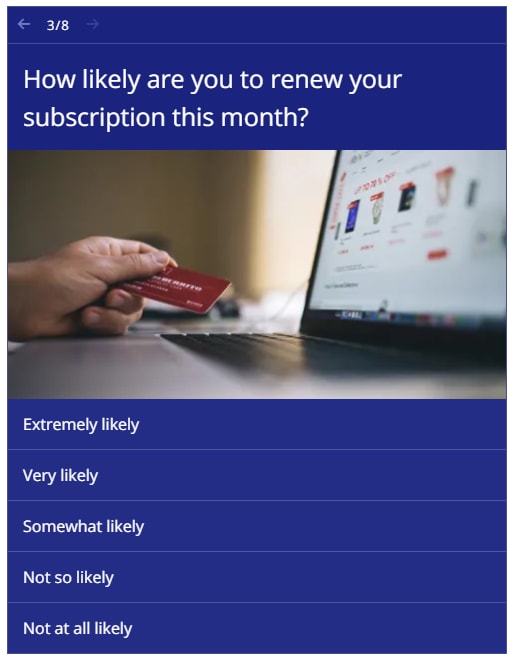Likert Scale Questions: Why You Should Use Them & How
Wondering how to measure people’s perceptions and attitudes toward a product, service, or experience? A Likert scale questionnaire is one of the most reliable methods of measuring opinions. Analyzing your data will be so much easier compared to yes-or-no surveys. This is because Likert scale surveys provide a wider range of answer options. Moreover, you can make excellent Likert scale surveys in no time using an online survey maker.
Let’s explore the makeup of Likert scale questionnaires.
What is a Likert Scale?
Likert scale questionnaires or Likert scale surveys are a type of survey questions that measures the extent to which people agree or disagree on a specific topic by asking respondents a series of questions. It comes with a range of answer options that can be numeric or verbal. This lets you gauge how someone perceives products, services, or experiences.
It usually consists of five or seven-point scales, ranging from one extreme to another. With a Likert scale, respondents aren’t forced to make binary responses. Because of this, they can also be neutral if they wish to. Compared to the usual yes-or-no surveys, it gives you a holistic view of people’s opinions. In turn, this lets you gather more valuable feedback.
What are Likert Scale Questions?
Aside from being easy to make, a Likert scale survey gives you highly valuable data. They allow you to understand the complex views and beliefs of your target audience. Plus, they deliver deeper insights into what people think and feel about a particular topic.
A Likert scale also helps you eliminate the usual challenges of survey design. For example, it lets you avoid asking broad questions that take too much time and energy to answer. Such questions can frustrate survey takers. As a result, this may force them to select answers that aren’t very accurate.
Using a Likert scale, respondents can focus on a single subject matter. Not only that, but they can also select the most accurate options when questions use simple, straightforward language.
Types of Scales
A Likert scale questionnaire can consist of either unipolar or bipolar questions. The former makes respondents think about the presence or lack of an attribute. Meanwhile, the latter prompts them to balance two opposite attributes.
Unipolar
In a unipolar scale, attributes fall on both sides of neutrality. That means there’s no natural midpoint. It starts with an extreme negative and ends with an extreme positive.
So, if you want to measure how likely it is that a person will recommend your product, you can use a unipolar scale. For example: not at all likely, not so likely, somewhat likely, very likely, and extremely likely. This makes respondents consider the presence or lack of a quality. In most cases, a unipolar scale is the better choice. This is simply because it’s easier for respondents to think about.
Bipolar
A bipolar scale also begins with an extreme negative and ends with an extreme positive, but it has a natural midpoint or neutral ground. For instance: extremely unlikely, unlikely, neutral, likely, and extremely likely.
Types of Likert Scale Responses
Likert scale responses range from one extreme to another. It’s ideal to have a greater variance in the answer options. As a result, you’ll be able to better understand your respondents’ opinions.
Here are the different types of responses you can use.
Acceptability
Likert scale questions can determine how much consumers accept or reject a quality or an attribute. Let’s say you want to use a bipolar seven-point scale. The responses can be: totally unacceptable, unacceptable, slightly unacceptable, neutral, slightly acceptable, acceptable, and totally acceptable.
You may also use a unipolar scale to measure the level of acceptability of a product, service, or experience. For example: not at all acceptable, not acceptable, somewhat acceptable, acceptable, and very acceptable.
Agreement
Likert scale questions are commonly used to gauge respondents’ level of agreement. Aside from being easy to write, the same questions and responses apply to nearly all industries.
For this type, you ask respondents how much they agree or disagree on something. Let’s say you prefer a bipolar five-point Likert scale. The responses can be: strongly agree, agree, neither agree nor disagree, disagree, and strongly disagree.
Appropriateness
Similarly, you can use Likert scale questions to gauge the level of appropriateness of a specific experience.
For this type, you can use a five-point unipolar scale. For instance: not at all appropriate, somewhat appropriate, appropriate, very appropriate, and extremely appropriate. But you can also use a bipolar scale. Very inappropriate, slightly inappropriate, neutral, slightly appropriate, and very appropriate.
Awareness
An awareness Likert scale can measure how much people know about something. In business, it can focus on a product, a service, or a recent event. It can also be used in an educational setting.
You can use a unipolar five-point scale to measure your target audience’s level of awareness. Try out responses like not at all aware, not aware, somewhat aware, aware, and very aware. You can also use a bipolar scale. For instance: totally unaware, unaware, neutral, aware, and totally aware.
Frequency
Ask frequency Likert scale questions when you’re trying to understand how often your target audience does a specific act. For example, say you’re trying to understand consumer habits. You can use it to find out how frequently someone purchases your product or pays for your service.
Measure the level of frequency with a seven or five-point scale. For instance, use always, often, sometimes, rarely, and never.
Importance
This type of scale is for when you’re trying to understand the level of importance of a line of products, services, or experiences.
You can use a unipolar scale. The responses can be: not at all important, somewhat important, important, slightly important, and very important. The problem with using this scale though is that it might make respondents feel confused. As a result, this can prompt them to make an inaccurate answer.
You can be more precise by adding a neutral midpoint. For instance: extremely important, very important, neutral, very unimportant, and extremely unimportant.
Likelihood
What if you want to measure how likely it is that a consumer will recommend or repurchase your product or service? You can then use a seven-point Likert scale. Extremely unlikely, unlikely, more or less unlikely, neutral, more or less likely, likely, and extremely likely.
Satisfaction
Lastly, we have the satisfaction Likert scale. Use this type if you want to gather feedback on products or services. You may also use it to measure someone’s level of satisfaction with a brand event or experience.
For this type of scale, you can use either unipolar or bipolar questions. Not at all satisfactory, not satisfactory, somewhat satisfactory, satisfactory, and very satisfactory.
Get Holistic Feedback through Likert Scale Surveys
Create a SurveyHow to Plan a Likert Scale Questionnaire?
Likert scale questions can gather data on a variety of subjects. They can reveal how your audience perceives your newest products. They can help you gauge how employees feel about company policies. Here are a few tips to help you make an effective Likert scale questionnaire.
1. Identify what you want to measure
What do you want to learn more about? Likert scale surveys aren’t meant to measure multiple factors. It works best if you’re only focusing on one subject matter. For instance, you can use it to gauge how your target audience feels about your customer service or your recent public event.
2. Focus on a single topic
A Likert scale survey must only focus on a single topic that can’t be understood with one question. That’s why you need to set indicators. These are specific types of questions that allow you to comprehend the topic you’re trying to measure.
3. Use simple, straightforward language
Always ask simple, straightforward questions to avoid confusion. Refrain from using unclear words or expressions. Moreover, avoid asking leading questions. This is because they can affect the analysis of your data. Leading questions prompt responders to provide answers that survey makers desire. In turn, this creates a bias in your research.
4. Ask questions instead of making statements
As humans, survey respondents tend to agree rather than disagree with statements. This is called the acquiescence response bias. Strive to prevent such bias. To do so, it’s better to ask simple, direct questions.
5. Select ideal Likert-type scale responses
Do you want to gather feedback for your new product or assess employee engagement? Some of the response types you can use include Agreement, Frequency, Satisfaction, and Likelihood. You can use these to measure various subjects in any way you want. Make sure to also stay consistent with the scales you use.
6. Add labels when using numbered scales
Refrain from using numbered scales that don’t have labels or descriptors. Respondents might get confused with numerical values alone. They might not know how to interpret the value of each scale point. Hence, if you insist on using numeric responses, make sure each one comes with a label.
7. Stick to odd numbers
Make scales with an odd number of values. You can add five or seven answer options. Anything greater than that isn’t ideal. That’s because respondents tend to choose answers randomly. Thus, this renders the data invaluable.
8. Test, analyze, and revise
Like other types of surveys, you can test and revise Likert scale questions. You can do this on repeat until you’re satisfied with the outcomes. This is to remove potential biases and improve your method of gathering data. So make sure to do pretests. Ask a small pool of respondents that represent the larger population.
Want to receive more audience insights?
Make a SurveyHow to Create a Likert Scale Questionnaire with Opinion Stage?
Opinion Stage is an interactive content creation platform. With it, you can design and deploy Likert scale questionnaires and other types of surveys in no time.
1. Start from scratch or select a template
Make a questionnaire from scratch with Opinion Stage, or choose a pre-made Likert scale survey template. Either way, you can set up a questionnaire in no time. All of our templates are designed by experts in survey design.
2. Add survey questions
If you’re new to Likert scale questionnaires, you can follow our templates and use our pre-made questions. You can also modify them to your liking so you can gather the data you need.
3. Configure the settings
Modify the settings of your Likert scale survey to suit your needs and goals. There are various features you can configure. This includes email notifications on submissions and a contact form. You can even place a call-to-action in the last part of the survey.
4. Customize the survey
Our templates are fully customizable. You can change the look and feel of our pre-made surveys so that they match your site or brand. Give your surveys a more personal touch. Add your brand’s logo. Modify fonts, font sizes, and colors.
5. Share the survey
Once satisfied with your Likert scale questionnaire, click on the “Embed & Share” button. Add it to your website, or share it on social media. You can also send it to your client base via email, make it a WhatsApp survey, or a Slack survey. The options are endless, simply choose the sharing strategy that makes the most sense for your needs and audiences.
Takeaway
Likert scale questionnaires are great for getting to know audiences and their consumption habits. You can gain deeper insights into their views, beliefs, and attitudes when you do it right. Hence, choose carefully between unipolar and bipolar scales to reduce confusion and miscommunication. When in doubt, use unipolar scales as they are simply easier to comprehend.
Ask questions, instead of statements. Avoid using numerical values without labels so respondents have no trouble interpreting the meaning of each point. Select the right Likert-type scale responses to gather valuable feedback. Moreover, keep testing, analyzing results, and revising your questionnaire.
Online survey tools like Opinion Stage have advanced reporting functions. This makes Likert scale analysis convenient and effective. You can view the results and statistics from an online dashboard. Using the data you gather, you can make well-informed decisions. For instance, use the insights to refine products in development. You can leverage the data to improve marketing or sales strategies. You may even use it to refine your questionnaire and gain more valuable feedback.
You can easily do it yourself, no developer needed
Make a Survey


